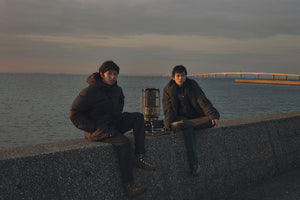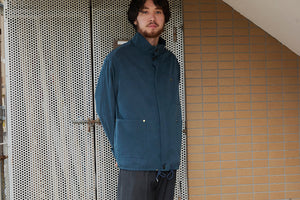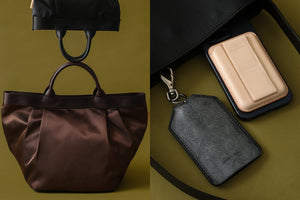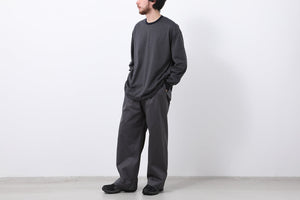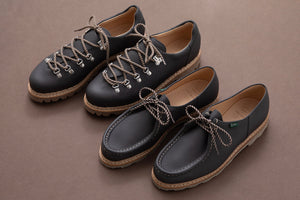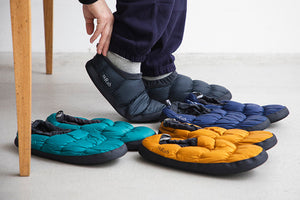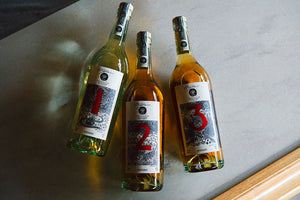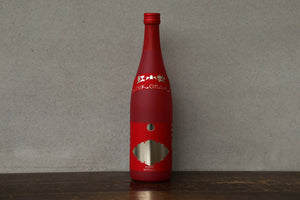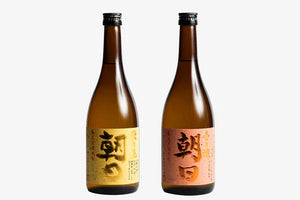
COVERCHORD CULTURE
“Yachimun” of Okinawa
Tousingama, Tsuboya-yaki
COVERCHORD visits Tousingama in Okinawa to learn about the distinctive style of Tsuboya-yaki.
Often known as “Yachimun”, Tsuboya-yaki is a unique form of pottery characterized by its simple, sturdy form and bold, decorative glazes. It is often painted with patterns inspired by Okinawa’s rich and colorful tropical landscape.
Like many traditional handicrafts, Yachimun has a long and compelling history that has influenced and shaped the beloved, daily-use pottery that we see today.
Intrigued by the charming vessels, COVERCHORD visited Tousingama, a ceramics studio in Yomitan village, to find out more about the history, people, and processes behind this art form.
Beauty and function
Tsuboya-yaki pottery

Made in Okinawa, this pottery is often referred to as “Yachimun”.
“Yachimun” simply means “ceramics” in the Okinawa dialect. The most well-known Yachimun - Tsuboya-yaki, can be broadly divided into two types; unglazed ara-yachi, which is often used to create large sake flasks and iconic mythical shisa lions; and glazed jyo-yachi, which is used to make crockery and other household items.
A blend of different Okinawan clay is used for Tsuboya-yaki and crafted into sturdy, simple forms, which are then finished with elegant painting to create a distinctive style.
The origin of Tsuboya-yaki is said to date back more than 300 years to when the Ryukyu Dynasty gathered skilled potters and kilns from all over the country to the Tsuboya area to develop its pottery industry. Unlike crafts on mainland Japan, Tsuboya pottery is heavily influenced by foreign cultures.
During the Ryukyu Dynasty era, Naha port became an active trade center connecting Japan, China, and Southeast Asia, introducing new materials, techniques, and artistic styles to the island.
As a craft form, Tsuboya-yaki has survived many periods of unrest, including the dissolution of the Ryukyu Kingdom and the Pacific War. Tsuboya-yaki withstood these turbulent times, continuing to add touches of color and beauty to home kitchens and dining tables in Okinawa. Today, the traditional style is popular with pottery enthusiasts around the world for its refined yet rustic charm.
‘Yachimun no Sato’
Yomitan Village

COVERCHORD paid a visit to Yomitan, a large village on the western coast of the main island of Okinawa, home to many artisans who continue to produce Tsuboya-yaki using traditional methods.
It is a serene place, with lush vegetation and clear blue seas, where locals coexist peacefully with their surroundings.
When the use of wood-fired kilns was prohibited in Naha in the 1970s due to concerns about pollution, some artisans switched to using gas or kerosene kilns but others relocated to Yomitan village, which is naturally rich in high-quality clay.
They established ‘Yachimun no Sato’, which is now home to more than 60 potteries that continue to craft beautiful household ceramics to this day.
Visiting Tousingama

The vivid coloring and striking patterns of Tsuboya-yaki makes them distinctive while also allowing them to blend in with modern tableware.
Of the many studios that make Tsuboya-yaki, COVERCHORD visited Tousingama - a pottery studio that boasts a particularly high production volume in comparison to many others and one that has been making daily-use ceramics for over 40 years.
We found Tousingama to be home to artisan potters who have dedicated their creativity to the “monozukuri” (craftsmanship) of Tsuboya-yaki.
The back of a veteran of 30 years.

The astounding craftsmanship and technical skill that can mold two hundred small rice bowls in a single day.
Tousingama’s motto
“Always Something New”
Tousingama was founded in 1975 in Onna village by its owner Masakazu Soma.
Soma, originally a chef on mainland Okinawa, decided to become a pupil of the late Ikuo Takaesu of Ikutouen, after falling in love with Okinawan Yachimun.
After founding his own pottery studio and moving his workshop to Yomitan, he now continues to uphold the traditional techniques for making Tsuboya-yaki, while creating daily-use ceramics under the motto “always something new”.
Eldest son of Masakazu and current workshop manager, Taisaku Soma, says that his father is “full of curiosity”. For example, when an Awamori distillery asked if he could make an Awamori bottle, he didn’t say “no, I can’t”.
Even if it has never been done before, even if it means making mistakes, he will face any challenge with determination and it is this attitude that has led him to many a success.
This curiosity and determination to always go above and beyond people’s expectations has become the very foundation of “Tousingama” itself, and has been passed on to the potters who work there.
The “constant pursuit of new things” embodied by Tousingama is not limited to the creation of new products.
In order to respond to ever-changing lifestyles and demands, they have embraced the internet, providing online shopping, utilizing crowd-fundraising, and actively using SNS.
At the same time, pottery workshops and their on-site cafe enable them to build deeper interactions with the people who physically visit the studio, as they consider “how to pass on” the traditional techniques that have been cultivated at Tousingama over the years.
Even if we are still not ready to accept something new right now, in fifty years’ time, that same thing might have become a historically respected part of tradition.
“One can’t make a living just by being proud.”
These words spoken by workshop manager Taisaku attest to the strong backbone of a cultural leader who will pass on Tsuboya-yaki to future generations.
The pottery wheel atelier. Specific tools are used for different items in order to assure uniform sizes.

Inside the studio, everybody is focused on their own work and a deep concentration fills the room.

Shavings produced during the throwing process are collected and mixed with water and clay to be reused. Care is taken not to waste limited resources.
Yachimun of Tousingama
The clay that is used at Tousingama to make jyo-yachi is brought in from the central northern area of Okinawa. Various kinds of clay are blended with Okinawan red clay which is then also treated to be able to withstand the temperature of the kiln. Because red clay becomes dark when fired on its own, it is coated with a cosmetic layer of white clay before being painted.
The patterns that are each drawn individually by hand are one of the most defining features of Tsuboya-yaki.
Traditional scrollwork, which was originally drawn as a wish for prosperity, or bold paintings of Okinawan plants such as tiger’s claw or bougainvillea; vivid red paintings or cobalt stain, fish patterns, slip trailing etc. The detailed glazes that Tousingama is known for are breathtakingly beautiful.
Tousingama uses about ten different glazes, including the traditional Tsuboya-yaki transparent glaze “Shirugusui”, which is made by firing with chaff and slaked lime from coral over three days before adding Gushikai white clay and white slip. As with the clay, specific glazes are used to match the final product.
Kerosene, gas, electricity, wood - another characteristic of Tousingama is that they use different kilns according to what they are firing.
In comparison with potteries that use only ascending kilns and only fire two to four times a year, Tousingama fires twice a week.
This just goes to show the incredible rate of production.
Affected by air temperature and humidity, the art of pottery is inseparable from the weather.

About ten different glazes are used according to the kind of ceramic being made.
Coating with white slip in preparation for painting. This is an important part of the creative process that must be done with speed and that can directly affect the quality of the final product.


The painting process is symbolic of Okinawan Yachimun. Patterns have been developed to retain quality while also allowing for faster production.
“Beauty” born from collaboration
At Tousingama, there is a complete division of labor in all parts of the production process that is undertaken by the ten or so artisans who work there.
Slab building, wheel throwing, painting, glazing, firing, dispatching - a dedicated staff member, who has mastered the peculiarities of each stage is assigned to each step of the process.
In a world where only after ten years of training can you call yourself “full-fledged”, the experienced potters entrust their skills to future generations, and trainees observe and learn.
Inside the studio, each artisan is completely focused on their own work as a sense of deep concentration fills the room.
More, faster - by successfully speeding up the production process without compromising at all on quality, pottery owner Masakazu reveals to us what he believes to be true craftsmanship - “Tarikido”.
The term “tarikido” refers to how craftsmanship is a tradition that cannot be upheld by a single person alone. A tradition that is made up of the natural elements used, such as earth or fire, and the skills that our predecessors have cultivated over many many years. Craftsmanship is also the “cooperation” needed for many people to come together to create a single piece of pottery. And finally, it is the beauty that is created when all these elements converge.
“Umarashimioure” is a prayer that means “please be born” in the Okinawan dialect.
Praise for nature, respect for our predecessors and thanks to the creator.
Today, Tousingama will once again, confide a prayer in its ceramics and place its trust in people.
Coating evenly with transparent glaze.
The process is completed in an almost ceremonial air.

These “setters” are used to adjust the height of the shelves in the kiln when firing.
At Tousingama, ceramics are never stacked when firing. The ceramics are positioned and repositioned extremely precisely so as to achieve an unblemished and uniform finish.

With a prayer “Umarashimisoure”
TOUSINGAMA
Address_2898-4 Yomitan, Zakimi, Nakagami District, Okinawa
Website_tousingama.com
Instagram_@potterycafegunjotousingama
JAPAN TRADITIONAL CRAFTS WEEK 2022
Translation_Yuko Caroline Omura




